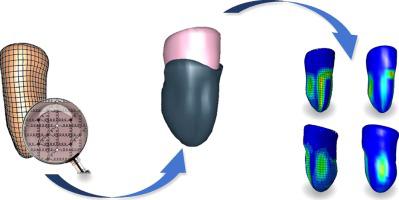IRBM ( IF 5.6 ) Pub Date : 2020-03-03 , DOI: 10.1016/j.irbm.2020.02.003 A. Ballit , I. Mougharbel , H. Ghaziri , T.-T. Dao

|
Prosthetic technology is rapidly advancing but there's a catch. Regardless the technology or the material used, a minimum cost is still high. One of the problems relates to the fact that the conventional socket fabrication process is still used. This method is based on subjective estimations of the involved specialists and feedbacks of the patients. This process consumes remarkable amount of time, manpower and materials. Research works are needed to design new efficient and low-cost alternative techniques for the socket design. This technique should definitely be based on CAD-CAM methods. Therefore, the first step toward this objective is to establish an accurate numeric model for evaluating and optimizing the design process. In this present work, we developed a new approach to simulate the stump soft tissue deformation and stump-socket interaction using Mass-Spring System (MSS) approach and a point-to-surface contact formulation.
A novel Mass-Spring System with corrective spring (MSS-CS) model was developed and evaluated. A node-to-surface contact formulation was also integrated and evaluated. The MSS-CS model and contact formulation were evaluated with primitive geometrical object and a stump-socket model. Moreover, a finite element model of the stump-socket interaction was also developed using Abaqus to evaluate the proposed approach.
Obtained results show that the proposed contact formulation has a very good precision level and the contact pressures on the interface between the elastic and rigid bodies are very close to the analytical solutions. The comparison with Abaqus showed a qualitative concordance for the contact pressure. However, quantitative deviation remains high [25-50]% at the peak contact pressure due to different contact formulations. In particular, our MSS-CS approach is more efficient than Abaqus simulation in term of computational time and cost.
A novel approach was proposed to model soft tissue deformation and stump-socket interaction in an efficient and accurate manner. As perspectives, this present approach for a real-time simulation of the stump-socket interaction could be used in a real-time CAD-CAM platform to provide a cost-effective socket manufacturing process.
中文翻译:

快速软组织变形和残端-桩相互作用朝下肢假肢计算机辅助设计系统发展
假肢技术正在迅速发展,但有一个陷阱。无论使用何种技术或材料,最低成本仍然很高。问题之一涉及仍然使用常规插座制造工艺的事实。该方法基于所涉及专家的主观估计和患者的反馈。该过程消耗大量时间,人力和物力。需要进行研究工作以设计用于插座设计的新的高效且低成本的替代技术。该技术绝对应基于CAD-CAM方法。因此,朝着这个目标迈出的第一步是建立一个准确的数值模型,以评估和优化设计过程。在本工作中,
开发并评估了带有修正弹簧(MSS-CS)模型的新型质量弹簧系统。还集成并评估了节点到表面的接触配方。用原始的几何物体和树桩-插座模型评估了MSS-CS模型和接触公式。此外,还使用Abaqus开发了树桩与插座相互作用的有限元模型,以评估所提出的方法。
所得结果表明,所提出的接触配方具有非常好的精度水平,并且弹性体和刚体之间的界面上的接触压力非常接近解析解。与Abaqus的比较表明接触压力在质量上是一致的。但是,由于接触配方的不同,在峰值接触压力下定量偏差仍然很高[25-50]%。特别是,在计算时间和成本方面,我们的MSS-CS方法比Abaqus仿真更有效。
提出了一种新颖的方法来以有效且准确的方式对软组织的变形和残肢与插座的相互作用进行建模。从角度来看,可以在实时CAD-CAM平台中使用这种用于树桩-插座相互作用的实时仿真的方法,以提供具有成本效益的插座制造工艺。











































 京公网安备 11010802027423号
京公网安备 11010802027423号